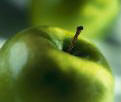
How to Eat an ORAC:
Superfoods May Slow Aging
(March 30, 2005)
Scientists at the USDA have
announced that eating high-ORAC foods may slow diseases associated with
aging. New test results show that an extract from baby apple skins may be
the next anti-aging superfood.
Baby boomers may have
a new weapon in the fight against aging and a host of age-related diseases,
simply by eating certain foods that score high on the ORAC scale.
ORAC stands for
Oxygen Radical Absorbance Capacity. The test was developed by researchers at
Boston's Tufts University and the USDA., as a way of measuring the
antioxidant power of foods.
If current findings
are borne out in further research, "young and middle-aged people may be able
to reduce risk of diseases of aging, including senility, simply by adding
high-ORAC foods to their diets," said Floyd P. Horn, former administrator of
ARS, the research arm of the U.S. Department of Agriculture.
Attacking the Underlying
Cause
Free radical damage,
or oxidative stress, is now accepted by many experts as a factor in every
degenerative disease related to aging.
"We're living too
short and dying too long," says medical nutritional specialist Ray D.
Strand, M.D. "Most of us can simply look forward to suffering and dying from
heart disease, cancer, stroke, diabetes, Alzheimerís dementia, Parkinsonís
disease, arthritis, macular degeneration, and the list goes on and on," says
Dr. Strand, "unless we literally attack the underlying cause of all of these
diseases- oxidative stress."
How to Eat an ORAC
Protecting yourself
from the ravages of aging and chronic disease is about to get easier, thanks
to the increasing popularity of the ORAC system.
Hundreds of foods
have been tested for their ORAC values over the last five years. And a
comprehensive look at the data is now in the works. "Our plan is that this
information will become part of the USDA Nutrient Database sometime later
this year (2005)," reports research chemist Ronald L. Prior, Ph.D.
Soon, you may see a
new addition to your food labels, listing antioxidant ORAC values beside
sugars, proteins, carbohydrates, and other contents.
News Flash: Mom was
Right
"Mom's been telling
you for years to eat your spinach because it's good for you," says David L.
Kern, health researcher and publisher of New Health and Longevity. "Now, we
not only know she was right, we know why."
Common fruits and
vegetables score high on the ORAC scale, but values vary widely. Kale, at
1770 ORAC units per serving, tops the vegetable list, followed by spinach
and Brussels sprouts. Prunes rate very high at 5770, with raisins and
blueberries following.
Foods vs. Superfoods
As the list of
ORAC-tested foods continues to grow, it will become easier for consumers to
fight aging with small changes in diet. But the most exciting news may be in
creating a new class of superfoods that exceed the ORAC value of even
high-ORAC vegetables and fruits.
"We've found some
fruit components and extracts that are nearly off the ORAC scale," says
Kern, who provides medical and nutritional anti-aging news to clients. "The
wave of the future is in foods fortified with high-powered antioxidant
ingredients. For instance, the skins of unripe apples have the highest
antioxidant power of any tested food by far, at 15,000 units. But they're
too bitter to eat."
ORACs in the
Millions
But by extracting the
phytochemicals from the apple skins, the antioxidant value is preserved,
concentrated, and highly available. These extracts can then be used to
fortify other foods, such as juices and energy drinks, to create "superfoods"
with extremely high ORAC values.
"We're seeing
readings in the millions of ORAC units with these fruit powders, compared on
a 100 gram basis, the standard food serving size used in the ORAC testing,"
says Kern. "That's exciting. Nothing else even compares."
For the estimated 175
million Americans who take antioxidants to protect their health and prevent
premature aging and disease, the rise of high-ORAC superfoods represents the
cutting edge of anti-aging nutrition.
To learn more about
high-ORAC foods and the health benefits of apple skin extracts, visit
www.applepoly.com/anti-aging.
-30-
(more news) |
